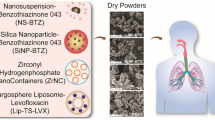Abstract
Purpose. Particles with aerodynamic diameters of 1–5μm deposit in the periphery of the lungs and are phagocytized by alveolarmacrophages, the primary site of Mycobacterium tuberculosisinfection. Aerosols of biodegradable polymeric microspheres containingantitubercular agents may be delivered to the lungs to improve the treatmentof tuberculosis.
Methods. Poly(lactide-co-glycolide) (PLGA) microspherescontaining rifampicin were prepared using solvent evaporation and spraydrying methods. The solvent evaporation process was optimized usingfactorial experimental design and surface response methodology. Themorphology, particle size, drug loading, and dissolution of microspheres wasevaluated.
Results. The spray dried rifampicin loaded PLGAmicroparticles were shriveled, unlike the spherical particles produced bysolvent evaporation. Drug loadings of 20;pc and 30;pc were achieved forsolvent evaporation and spray dried products, respectively. The particlesprepared by solvent evaporation and spray drying had 3.45 μm and 2.76μm median diameters by volume, respectively.
Conclusions. Respirable rifampicin loaded PLGAmicrospheres were produced by both solvent evaporation and spray dryingmethods. These particles are being evaluated in an animal model oftuberculosis.
Similar content being viewed by others
REFERENCES
J. L. Ho and L. W. Riley. Defenses against tuberculosis. In R. G. Crystal and J. B. West (eds.), THE LUNG: Scientific Foundations, Lippincott-Raven Publishers, Philadelphia, 1997, pp. 2381–2394.
J. H. Grosset. Bacteriology of tuberculosis. In L. B. Reichman and E. S. Hershfield (eds.), Tuberculosis: A Comprehensive International Approach, Marcel Dekker, Inc., New York, 1993, pp. 49–74.
M. T. Kenny and B. Srates. Metabolism and pharmacokinetics of the antibiotic rifampin. Drug Metab. Rev. 12:159–218 (1981).
L. R. Beck, D. R. Cowsar, D. H. Lewis, R. J. Cosgrove, C. T. Riddle, S. L. Lowry, and T. Epperly. A new long-acting injectable microcapsule system for the administration of progesterone. Fertil. Steril. 31:545–551 (1979).
B. W. Wagenaar and B. W. Müller. Piroxicam release from spraydried biodegradable microspheres. Biomaterials 15:49–54 (1994).
G. E. P. Box, W. G. Hunter, and J. S. Hunter. Statistics for Experimenters, John Wiley & Sons, New York, 1978.
G. E. P. Box and D. W. Behnken. Some new three level designs for the study of quantitative variables. Technometrics 2:455–475 (1960).
P. C. Reist. Aerosol Science and Technology, McGraw-Hill, Inc., New York, 1993.
A. Weber, K. E. Opheim, A. L. Smith, and K. Wong. High-pressure liquid chromatographic quantitation of rifampicin and its two major metabolites in urine and serum. Rev. Infect. Diseases 5:S433–S439 (1983).
E. B. Denkbas, X. Kaitian, A. Tuncel, and E. Piskin. Rifampicin-carrying poly(D,L-lactide) microspheres: Loading and release. J. Biomat. Sci., Polym. Ed. 6:815–825 (1994).
G. Derringer and R. Suich. Simultaneous optimization of several response variables. J. Quality Tech. 12:214–219 (1980).
M. Sacchetti and M. M. Van Oort. Spray-drying and supercritical fluid particle generation techniques. In A. J. Hickey (ed.), Inhalation Aerosols: Physical and Biological Basis for Therapy, Marcel Dekker, Inc., New York, 1996, pp. 337–384.
F. Pavanetto, B. Conti, I. Genta, and P. Giunchedi. Solvent evaporation, solvent extraction and spray drying for polylactide microsphere preparation. Int. J. Pharm. 84:151–159 (1992).
G. Spenlehauer, M. Vert, J. P. Benoit, and A. Boddaert. In vitro and in vivo degradation of poly(D,L lactide/glycolide) type microspheres made by solvent evaporation method. Biomaterials 10:557–563 (1989).
R. Bodmeier and H. Chen. Preparation of biodegradable poly(· -+) lactide microparticles using a spray-drying technique. J. Pharmacol. 40:754–757 (1988).
J. K. Lalla and K. Sapna. Biodegradable microspheres of poly(DL-lactic acid) containing piroxicam as a model drug for controlled release via the parenteral route. J. Microencapsulation 10:449–460 (1993).
T. Sato, M. Kanke, H. G. Schroeder, and P. P. DeLuca. Porous biodegradable microspheres for controlled drug delivery. I. Assessment of processing conditions and solvent removal techniques. Pharm. Res. 5:21–30 (1988).
J. P. Benoit and C. Thies. Microsphere morphology. In S. Benita (ed.), Microencapsulation: Methods and Industrial Applications, Marcel Dekker, Inc., New York, 1996, pp. 133–154.
S. Izumikawa, S. Yoshioka, Y. Aso, and Y. Takeda. Preparation of poly(l-lactide) microspheres of different crystalline morphology and effect of crystalline morphology on drug release rate. J. Cont. Rel. 15:133–140 (1991).
E. Celikkaya, E. B. Denkbas, and E. Piskin. Rifampicin carrying poly(D,L-lactide)/poly(ethylene glycol) microspheres: loading and release. Artif. Organs 20:743–751 (1996).
E. L. Barrow, G. A. Winchester, J. K. Staas, D. C. Quenelle, and W. W. Barrow. Use of microsphere technology for targeted delivery of rifampicin to Mycobacterium tuberculosis-infected macrophages. Antimicrob. Agents Chemother. 42:2682–2689 (1998).
R. Jeyanthi, R. C. Mehta, B. C. Thanoo, and P. P. DeLuca. Effect of processing parameters on the properties of peptide-containing PLGA microspheres. J. Microencapsulation 14:163–174 (1997).
A. J. Hickey, S. Suarez, M. Bhat, P. O'Hara, C. B. Lalor, K. Atkins, R. Hopfer, and D. N. McMurray. Efficacy of rifampicinpoly( lactide-co-glycolide) microspheres in treating tuberculosis. In R. N. Dalby, P. R. Byron, and S. J. Farr (eds.), Respiratory Drug Delivery VI, Interpharm Press, Inc., Buffalo Grove, IL, 1998, pp. 201–209.
Author information
Authors and Affiliations
Rights and permissions
About this article
Cite this article
O'Hara, P., Hickey, A.J. Respirable PLGA Microspheres Containing Rifampicin for the Treatment of Tuberculosis: Manufacture and Characterization. Pharm Res 17, 955–961 (2000). https://doi.org/10.1023/A:1007527204887
Issue Date:
DOI: https://doi.org/10.1023/A:1007527204887




